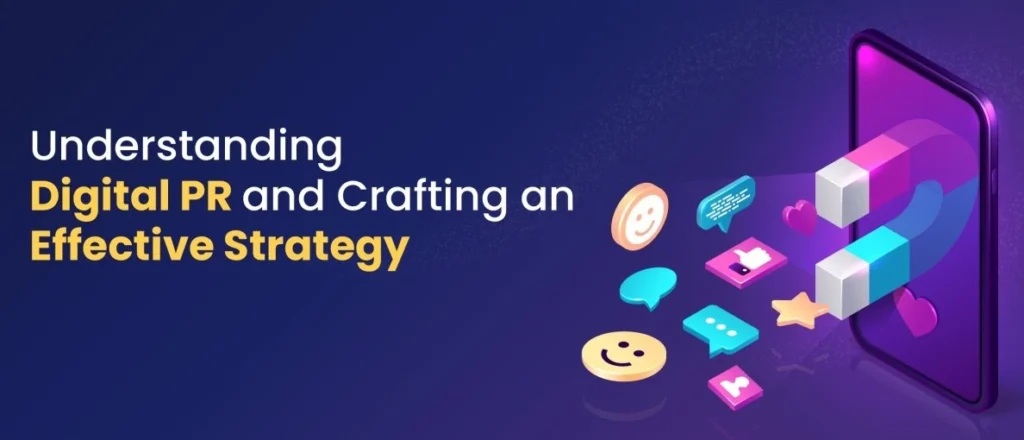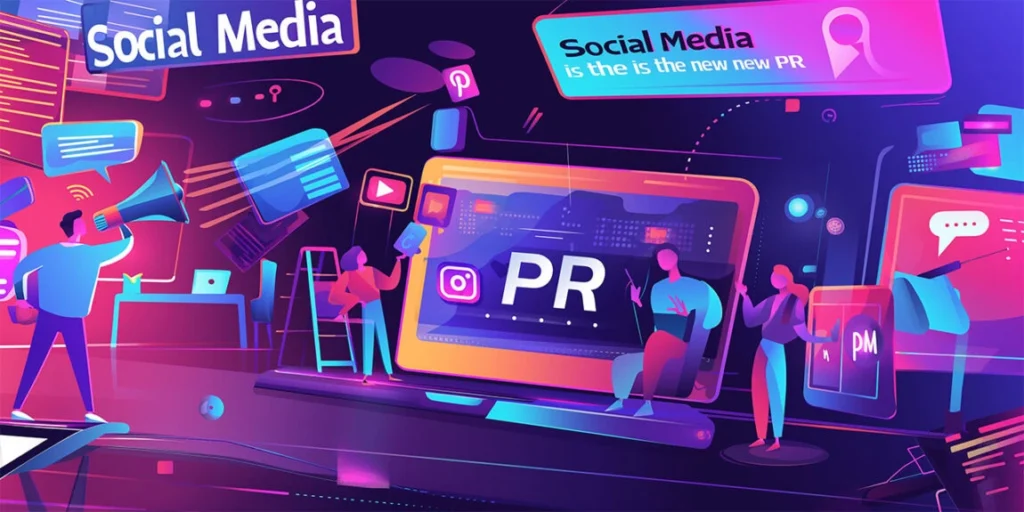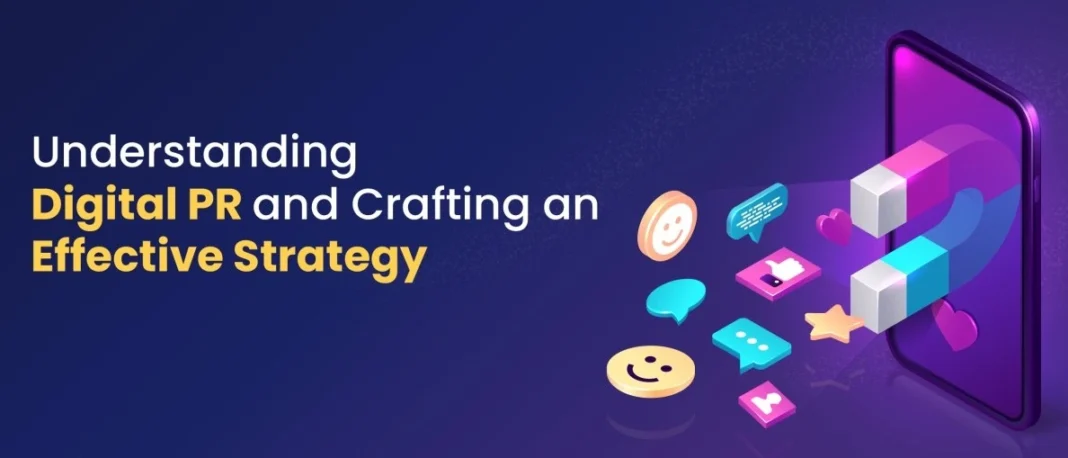What is Digital PR and How Can You Develop an Effective Strategy?
Digital Public Relations (PR) is a strategy used to increase awareness and visibility of your brand using online channels. Digital PR is similar to traditional PR but it offers the opportunity to reach more people in a measurable and targeted way.
To make the most impact, digital PR relies on digital marketing strategies such as search engine optimization (SEO), content marketing, influencer marketing, and social media.

Digital PR is a powerful strategy that allows companies to speak directly to their target audience and buyer personas at any time and anywhere.
By connecting and sharing with your audience, it’s possible to start a dialogue that clarifies your focus and spreads news and information more quickly.
Digital PR Vs. Traditional PR

Traditional PR involves networking with journalists to get featured in print publications. At one time, the goal of a publicist who specialized in traditional PR was to leverage contact to get their clients promoted or quoted in media (e.g. newspapers, magazines, radio, and television) or crisis reputation management.
Today, most traditional PR specialists have adapted to include digital PR – often finding higher readerships or viewership in online content – although traditional forms of PR are still used effectively.
Here’s the well-known “PESO media model for PR” created by Valerie Turgeon to show the different types of media that PR pros can target.
PESO Model
Using digital PR provides opportunities for marketers to:
Get interviews in online publications
Increase an online presence
Use the power of social media to drive growth and brand recognition
” PR is a cost-effective addition to your overall strategy and can have a significant impact on your reputation in your industry. Ensure your content is integrated into the agreed content pillars and SEO strategy for the wider business “
– Julie Atherton, Founder, Small Wonder
What Does Digital PR Involve?
With billions of people active online, businesses need to use digital channels for PR activities.
Good digital PR agencies combine the best of traditional PR with a focus on trends in content marketing, SEO, and social media marketing.
A digital PR specialist uses a variety of tactics to improve the presence of a company or client such as:
Creating and sending out press releases
Building relationships with online journalists and bloggers
Organizing online reviews and interviews
Ensuring press releases are optimized with relevant links to your website.
Using influencer marketing and blogger outreach to develop partnerships or get mentions on influential social media accounts and blogs
Publishing online content to gain a wider reputation and high-quality backlinks
What are the Benefits of Digital PR?
When you begin a digital PR campaign, you’re striving to improve brand awareness and online presence.
A focused campaign can make a big difference in establishing your online identity and what makes your brand unique.Here are some of the ways digital PR can benefit your brand:
Boost website traffic – Once your brand gets mentioned online more frequently, more people will start to visit your website.
Improve SEO and search ranking score – When your content is published on high-authority sites that link to your website, your SEO ranking will improve for your target keywords.
Establish a company as an authority – Publishing high-quality articles on authority sites will improve your reputation as a credible source of information and improve trust.
Generate earned links – By using digital PR you can get mentions online that are high-quality and earned rather than paid.
Generate leads and sales – Once your brand is mentioned more frequently, you will generate leads from people who visit your website leading to more sales.
Improve your brand image and increase trust – Your target audience will begin to hear more good things about your brand and see an increased number of positive customer reviews.
Easily track success – Unlike traditional PR which was often aimed at a broad audience and hard to measure, using UTMs or tracking parameters you can see how your PR campaign is performing.
Be cost-effective – The benefit of PR is that it doesn’t need to cost the earth. A simple press release or reach out to an established journalist or blogger could get traction.
How to repurpose your content for PR
Content marketing is an important part of a digital PR campaign. The more your content is shared and found, the more your reputation and status as an authority begin to grow.
For example, a single blog post can be repurposed into several other types of content such as:
Infographic
Expanded guest blog
An article in the local newspaper
Article in a trade publication
LinkedIn article
Social media post
Short video
In this way, one piece of content can be transformed to serve multiple sources that can be shared to help promote and grow your reputation. It’s not simply rewriting the content, but continue adding value and reinforcing your voice as an authority.
Top tip: Consider other ways to help boost your content such as using local SEO or turning it into a podcast. You can also use Google’s AI-powered Notebook LM tool to create a podcast from existing content – watch this walktrhough to see how.
How to use social media for PR
Few tools are more powerful in a digital PR campaign than social media.
Through social media, you can connect with customers and influencers, study the strategy of your competitors and continually engage in conversations about your niche.
As you continue to write and publish additional quality content, continue to promote it on social media channels and encourage others to share and promote it. Offer value and information that is worth sharing and worth discussing.

Top tips for using social media for PR
Remember, PR is focused on improving your business’s reputation and building trust. The top tips for PR on social media are:
Integrate PR into other activities: Make sure your PR strategy is integrated with all your social media activity, including keywords and hashtags.
Integrate offline and online events: Use social media to promote offline and online events before, during, and after the event. Follow-up posts after the event can summarize key points and be shared and commented on.
Use live tweeting: This can provide commentary and spark interaction around both online and offline events.
Livestream events: Use social media channels like Instagram Live and LinkedIn Live to host real-time events and create content for future marketing and PR activity.
Vary the events: Mix the types of events you offer to add value and interest e.g. webinars, podcasts, live streams, etc.
Co-host: Consider co-hosting events with other businesses or taking part in events specific to your sector to increase reach and impact.
Connect with others: Make sure you connect with and follow relevant businesses and individuals from events and other PR activities.
Coordinate with others: Coordinate your social media activity with journalists and partners for all PR campaigns.
Prepare for a social media crisis: Consider the potential negative impacts of a PR campaign by having a social media crisis management framework in place.
How can marketing and digital PR work together?
While marketing is focused on leads and sales, PR focuses more on creating a positive impression of your brand.
Digital PR aims to get the word out about what your brand stands for and what makes it unique. It aims to increase brand visibility and authority to generate positive brand awareness.
It’s necessary to build relationships and reputation before marketing can be effective. So, digital PR and marketing should work together, with each strategy complementing and enriching the other.
How to start a digital PR campaign
Whether you run your digital PR or use a digital PR agency, getting started is important. Once you start taking advantage of online channels to begin building your brand, you can analyze what is working and what isn’t and make changes if necessary.
So how can you start?
1. Know your target audience. Use surveys and social media interaction to get to know the people who are interested in your brand and its message. The creation of distinct buyer personas will also help.
2. Set your goals – Understand your goals and KPIs for your digital PR activities and track them.
3. Build key relationships – Research and use data to produce authoritative content by building relationships with influencers and top bloggers in your niche.
4. Brainstorm ideas – You know what you want to say, but how can you say it to cut through the noise online? Content ideation is one of the hardest but most important elements. Get that right and you will drive engagement. Make sure to include research at this stage too so you know what you are communicating is accurate and relevant.
5. Look at your resources – How much time you have available for digital PR may be a factor in whether you decide to do it yourself or to outsource. Think about outsourcing all or part of your digital PR if you are low on time.
The more digital PR strategies that you use, the more likely you will improve your brand’s reputation and successfully grow your business.
How to measure the success of a digital PR campaign
One of the great things about digital PR is that it is trackable and measurable. This means you can see what campaigns or messages are seeing success and those that fall flat.
But what metrics should you use to measure and report performance?
Social shares – How many times was the campaign or article shared on social media and by whom?
Leads or Revenue – Can you attribute any leads or revenue to the campaign? You can see this by looking in GA4 at the first page or the last page visited or setting up an ‘Event’ goal. Or was there a spike in revenue when the campaign launched or ran?
ROI – Was there a good ROI for the campaign? This could be visibility, web traffic, brand sentiment, or revenue.
Ultimately your digital PR strategy should concentrate on providing useful and informative content for your audience. You should also ensure that your content is integrated into the content pillars and SEO strategy for the wider business.








